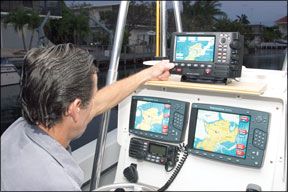The CPV350 has a long list of features that go beyond the ability to transmit and receive. It has an integral 30-watt hailer with automatic and manual foghorn capability, sophisticated DSC capabilities with a second receiver for receiving channel 70 digital signals, an easy-to-access menu, and a large rotary knob for channel selection that doubles as a range and zoom tool for the chartplotter. It is WAAS and AIS capable (when coupled with an AIS receiver). Its 7-inch, high-resolution (800-x-480), color display is comparable to that of the Navman Trackfish 6600, Practical Sailor s Best Choice among tall screen plotter/sounders reviewed in the June 2006 issue. The main drawback we see in the CPV350 is that by having one device that handles multiple duties, system redundancy is lost.
****

288
Occasionally, a product hits the market that can’t be easily categorized. Case in point: the Standard Horizon CPV350 (http://www.standardhorizon.com/). Its a marine VHF radio, chartplotter, and even has sounder capability when it is paired with the Standard Horizon FF520 black box sounder. Its a perfect fit for small boats with small instrument panels where space for electronics can be very limited.
The CPV350 has a long list of features that go beyond the ability to transmit and receive. It has an integral 30-watt hailer with automatic and manual foghorn capability, which allows for reception of VHF voice signals even while in the P.A. or Fog Horn mode. Other important features include sophisticated DSC capabilities with a second receiver dedicated solely to receiving channel 70 digital signals, an easy-to-access menu, and a large rotary knob for channel selection that doubles as a range and zoom tool for the chartplotter. The device is also AIS capable when coupled with an AIS receiver. It can be used with up to two Standard Horizon remote microphones, too. (Look for Practical Sailors test of remote VHF mics in an upcoming issue.)
Although the CPV350 can interface with the companys FF520 fishfinder, we did not test this feature.
The CPV350 has a 7-inch color display screen with a resolution of 800 x 480. The display is comparable to that of the Navman Trackfish 6600, PSs Best Choice among tall screen plotter/sounders reviewed in the June 2006 issue. It has the same resolution and a slightly smaller screen.
For testing, we mounted the unit using the plastic bracket shipped with it. In a permanent installation-wherever it is possible-wed opt for a flush mount for a display unit this big.
We found the CPV350 screen to be bright and sharp in daylight conditions. The best view, in our opinion, was the Sunlight color palette. The Normal setting also worked well, but the Classic setting was a little dark in the daylight for our liking. Night Vision mode darkens the screen to reduce glare and improve low-light viewing. While viewing the screen in daylight with polarized sunglasses, we noticed it darkened slightly even when viewed from directly in front. Viewed from 45 degrees, it was just about blacked out. According to Standard Horizon spokesman Scott Iverson, blackout at severe angles is normal for most LCD screens when viewed with polarized sunglasses. Weve had mixed results in our testing experience. Some, like the Furuno GP-7000F, had no darkening, while others like the JRC Plot 500F had slight darkening.
Without the glasses, the Standard Horizon CPV350s screen was usable at this angle. Testers found it necessary to be close to the screen to read small details, like depth numbers, on the map page. Screen details can be made larger via the main menu. We found that the larger size created a clutter of names and numbers. Also, the size of the mark and waypoint names did not change. This characteristic was especially noticeable at night and is the reason we rated the screen Good instead of Excellent for both day and night viewing. Unfortunately, this is a consequence of having such a high resolution displayed on a screen of this size. Wed still opt for this combination over a lower-resolution screen of the same size.
We found the CPV350 plotter easy to operate with its pushbuttons, joystick, and menu-selectable functions. We gave it a Good rating for plotter user-interface. We see the lack of an alphanumeric keypad as a disadvantage, particularly when entering data like waypoint names. Five soft keys add operational flexibility on the pages where they are functional. If their function labels are not displayed, pressing any soft key will bring up all active soft key labels. We found chart redraw to be about average, things can take a few seconds to display when shifting ranges quickly. With its C-Map Max card installed, the CPV350 ranged down to very fine detail.
The course predictor on the CPV350 works well and is adjustable; like some other fine details though, it can be hard to see. Data blocks are displayed across the top of the map page in a variety of ways that are user adjustable. Hitting the enter key, followed by another button push or two will yield a waypoint at the current or selected cursor position. This action also brings up soft key functions that allow you to manipulate the waypoint.
A new update allows the storage of up to 3,000 waypoints and 50 routes. Waypoint names can use 10 characters and one of 16 symbols.
The CPV350s built-in GPS in WAAS capable, and its sensitivity and selectivity are as impressive as its VHF performance.
Conclusion
We like the CPV350 for all its capabilities that are placed so well in a reasonably sized and reasonably priced package. And it has a three-year warranty.
The main drawback we see in the CPV350 is that by having one device that handles multiple duties, system redundancy is lost. If that one device fails, youre out of luck. CPV350 users would do well to keep a backup handheld VHF and handheld GPS onboard.

































